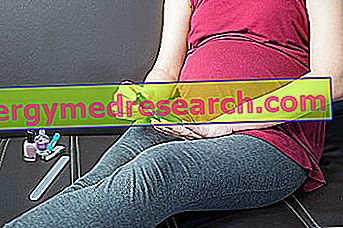What's this ?
The spiral represents an important alternative method for contraception: it is a small device of various shapes, which is introduced into the woman's uterus by a gynecologist, generally during menstruation, and left there for some years.
The contraceptive spiral is known as IUD, an Anglo-Saxon acronym of Intra Uterine Device : the contraceptive effect is guaranteed by the prevention of fertilization or by the obstruction of the implant in the uterus of the embryo.
There are two types of spirals on the market: hormonal IUDs and copper IUDs.
Hormonal contraceptive spiral

The hormone is released by the endocrine gland that produces it (corpus luteum): the spiral acts on the endometrium and cervical mucus. In the first case, the device makes the endometrium particularly thin and unstable, thus denying any possibility of implanting the egg; at the level of the cervical mucus, on the other hand, the hormonal contraceptive spiral prevents the passage of spermatozoa.
The contraceptive action is guaranteed for 3/5 years, after which the spiral is removed and eventually replaced with a new one.
Copper contraceptive spiral
The copper spiral is a small plastic device surrounded by a thin spiraled copper wire (hence the name "spiral").

Copper, which surrounds the plastic support, exerts an excellent spermicidal action: so much so that copper, at the level of the uterus, frees its ions preventing the fertilization of the egg and hindering sperm motility and survival .
Depending on the type of spiral used, the contraceptive action varies from 3 to 5 years.
Contraindications
Theoretically, the contraceptive spiral could be inserted by the gynecologist into the uterus of all women of childbearing age; however, on a practical level, this model of contraception is only recommended for women who have had at least one pregnancy, to be certain of their fertility.
Furthermore, the contraceptive spiral should not be introduced into women prone to vaginal infections, since bacteria could more easily nest near the spiral and generate rather unpleasant disorders. It has been statistically recorded that women who do not have children are more prone to infections than mothers: this explains why the contraceptive spiral is preferable in women who have already given birth at least once.
Furthermore, women suffering from vulvodynia or other pelvic inflammation should not use the spiral.
Insertion of the contraceptive spiral
The contraceptive spiral is inserted deeply into the uterus by the gynecologist, preferably during menstruation, since the dilated uterine neck facilitates its application.
As already mentioned, the woman must undergo a gynecological examination, so the doctor can choose the most suitable spiral model for the woman's uterus structure. After ascertaining that the woman is not pregnant, the doctor performs a swab and / or pap test to the patient to exclude any possible local infectious form.
The insertion of the spiral is performed in an outpatient manner; however, the perception of the discomfort / pain related to the application can be of varying intensity, based on the sensitivity of the patient, to the subjectivity of the same and (above all) based on the "delicacy" of the gynecologist. To avoid this discomfort, the doctor may give the woman a specific painkiller before the operation.
The spiral is gently pushed into the uterus through the cervix, previously cleaned with an antiseptic substance; the copper wire is then cut by the doctor to prevent it from going too far out of the cervix.
In order to avoid bacterial infections, it is absolutely essential for the woman to avoid sexual intercourse and the use of internal vaginal swabs for the next two days after the application of the spiral.
Advantages
Many women choose the contraceptive spiral because it offers many advantages:- Unlike the contraceptive pill, which must be taken about every day at the same time to take advantage of its maximum effectiveness, the contraceptive spiral is inserted into the uterus, and remains there for a few years, always guaranteeing an excellent contraceptive effect. It is therefore impossible for the spiral to be forgotten, as is the case for many women who use the pill.
- The contraceptive safety of the spiral, in particular that of slow hormonal release, ensures extraordinary contraception (contraceptive safety of the latest generation spirals of 99.9%): in any case, the woman must periodically check that the spiral is positioned correctly.
- The periodic release of the progestogen, in minimal quantities, allows to significantly reduce the menstrual flow, avoiding heavy menstruation. It is estimated that 20% of women who use the hormonal spiral no longer present menstruation, a factor considered positive by many women. However, with regard to the copper spiral, the flow of menstruation of women who use it generally does not decrease.
- The hormonal spiral greatly reduces menstrual disorders such as menorrhagia and dysmenorrhea.
- The gradual release, albeit continuous, of the progestin reduces the risk of endometrial polyps and uterine hyperplasia.
- The application of the spiral within the next three days from a potentially risky relationship guarantees 99% of the contraceptive effect.
- The spiral can be removed at any time and then the woman, when she wishes, can have another pregnancy (rapid reversibility of the effect).
- The spiral is an excellent alternative for women who do not want to take the pill or the trans dermal contraceptive patch.
Disadvantages
Like all contraceptive methods, the spiral also has unwelcome side effects:
- Breast swelling, acne, migraine and the perception of generalized swelling are the most frequent side effects in women using the progestin spiral. Just like the pill, the contraceptive efficacy of this spiral pattern could also be compromised by the concomitant use of some drugs.
- Women predisposed to vaginal infections should not use the spiral.
- The hormonal release spiral could cause vaginal dryness and hot flashes, similar to those of menopause.
- The copper spiral could cause spotting in the first few months after application: generally, the phenomenon disappears in a short period. Nevertheless, when the gynecologist does not correctly insert the spiral, or in any case does not find the model of contraceptive device best suited to the structure of the woman's uterus, spotting is a recurrent phenomenon, taking the form of the first indicator that should immediately alert the woman.
- The spiral is absolutely not recommended in women predisposed to salpingitis, cervicitis and pelvic inflammatory diseases.
- Statistics show that 20% of women using the contraceptive spiral suffer from oligomenorrhea and amenorrhea in the first months after application.
- The spiral fails in 1-2% of cases, causing unwanted pregnancy.
- During the menstrual cycle, the spiral could shift or be removed from the uterus.
- The spiral does not protect from sexually transmitted diseases: in this regard, the spiral is recommended for women with a fixed partner. If the woman changes partners, the use of condoms is preferable (barrier method).
Benefits of the contraceptive spiral | Disadvantages of the contraceptive spiral |
|
|
Positioning control
Considering that the spiral could shift during menstruation (a phenomenon that is still rare), it would be good for the woman to always check the presence of the spiral after the cycle: it should introduce a finger into the vagina and feel the presence of the thread. In fact, as analyzed above, at the time of application of the spiral the doctor cuts the wire a few centimeters, usually 3 or 4, to allow the cord to come out slightly from the cervix, thus helping the woman to control the spiral. When the woman perceives the plastic device, during self-control, she will have to go to the doctor, because some complications might be in place.
During the relationship
When the contraceptive spiral is inserted correctly, it is very unlikely that the partner can notice the device: in fact, only by touch (with the introduction of the finger in the vagina) can the thread be felt.
Periodic gynecological checks
The first check is advised after the first month after the application of the contraceptive spiral: in this way, the doctor can ascertain the good health of the woman and instruct her to self-control the contraceptive spiral. In general, gynecological checks must then be repeated every six months.



